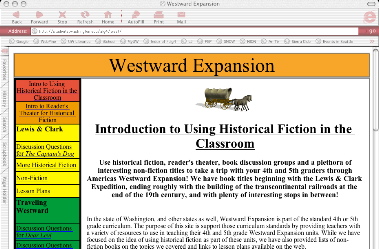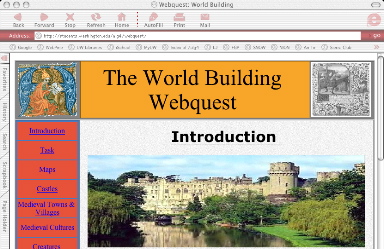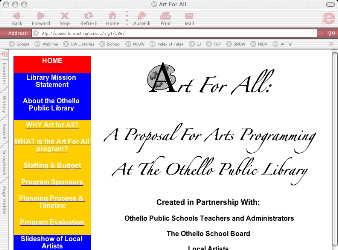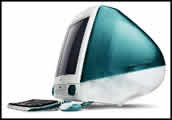|
HOME
Resume
References
Coursework
Practical Experience
Teaching Experience
Leadership Experience
Intellectual Experience
Technology Experience
|
|
Technology Experience
Significance: Developing a New Set of Technology Skills
As an undergraduate at Drexel University, I had done some
basic web
page editing as part of my work study job in the Information Services
department of Hagerty Library. This consisted of updating, editing, and
checking pages on the Drexel University Library web site using the
WYSIWYG (What You See Is What You Get) web page editing functions in
Dreamweaver, and the library's standardized page templates. This gave me the chance to learn
a bit about how to use Dreamweaver, but since I was using a WYSIWYG
web editing program I learned very little
about writing HTML. Before I came to the iSchool I had never done any
original web design.
The web design projects presented in this page are significant because
they represent the first original web design I have done, because they
represent the end results of what I have learned about web design at the
iSchool, and because each represents a significant project using the
information technology of web sites to organize,
present, and give access to
information. In each new project I have learned more about applying
the information technology skills I gained in LIS 541 Internet Technologies & Applications
and LIS 540 Information Systems, Architectures and Retrieval,
and discovered new things that I want to learn about how to do web design. For
each project I have also had to think about how best to
organize the information within the web site so that the organization of
materials is sensible and clear, making that information easy to access. I
have learned that
web site design is not just a
technological problem, but rather a more complex process with what seem to
be three essential elements, each of which needs to be addressed to create
a
good, user-friendly web site:
- Technology: the formatting or code that forms the web site,
- Content: as the raison d'etrê for the web site I
have found that content needs not only to be well-written, but also clearly
and logically organized in a way that makes it easy to navigate,
- Graphic Design: I have found that because a web site is an essentially
graphical format good layout and graphic design are essential to making
a web page work well, that they are a huge part of
the appeal or lack
of appeal of a website, and that they can make a huge difference in how
easy site
content is to read and navigate.
In all the work I have done, I have striven to follow the principles of user-centered design that we
studied in LIS 540 Information Systems,
Architectures and Retrieval.
Learning Web Design
When I started my studies at the iSchool in September 2003, I knew
that one of the things I wanted to learn was how to design web pages. On the
one hand, I knew web design skills were a marketable commodity, and that having
them would be an asset. On the other, I really looked forward to the creative
and artistic aspects of web design. So, I took LIS 541 Internet Technologies and
Applications in Fall 2003,
my first term at the iSchool. It was a wonderful class, and in addition
to learning about web page design I learned many things about
communications technology. From taking this course, I gained the following
web design skills:
- Writing and editing HTML and XHTML.
- Methods for formatting the the layout of page content, including
frames and tables.
- How to use Cascading Style Sheets (CSS) to format web pages
within a site consistently, creating an overall consistent look and
feel to the site.
- How to use Server Side Includes (SSI) to display items like the date
and time a page was last updated, or to display a uniform navigation bar
and header on each page of a web site.
- How to create links between pages and sections of pages; how
to develop effective site navigation.
- How to add images and multi-media elements to web pages.
- How to add forms to web pages.
- How to find and incorporate pieces of open source code to add features
and functions to web pages.
- How to use existing free services to add basic searchability to a web
site.
- How to publish web sites and register domain names.
In addition to these web design and development skills, I learned about:
- The protocols that govern different types of information transfer over
computer networks, including those for e-mail and ftp.
- How to set up and use a variety of e-mail and ftp programs.
As the final project for this class I created my first web
site:
 This is a fun informational web
site about hot peppers including images and descriptions of many
varieties of peppers, information on growing peppers, health and
medicinal applications of hot peppers, recipes, and hot sauce reviews.
While I had a lot of fun with the graphic design problems and the research
for this web site, mostly I learned a great deal about web design. This
project provided a great opportunity to bring together and apply all the
pieces of what we had learned in the class in a "practical" hands on
project. I derived an immense satisfaction from working on and completing
this project, and from knowing that I could take the skills I had
developed and use them to create a wide variety of web based information
tools.
This is a fun informational web
site about hot peppers including images and descriptions of many
varieties of peppers, information on growing peppers, health and
medicinal applications of hot peppers, recipes, and hot sauce reviews.
While I had a lot of fun with the graphic design problems and the research
for this web site, mostly I learned a great deal about web design. This
project provided a great opportunity to bring together and apply all the
pieces of what we had learned in the class in a "practical" hands on
project. I derived an immense satisfaction from working on and completing
this project, and from knowing that I could take the skills I had
developed and use them to create a wide variety of web based information
tools.
Putting Information Technology Skills to Work:
Pathfinders, Webquests,and Promoting Library Programs
Web sites are an information technology that provides a multitude of a
opportunities for delivering and providing access to information. In the
library world we use them to provide access to the library catalog, to
display information about the library, to display lists of recommended
titles, to give patrons access to electronic resources, and to answer
reference questions. But these are just the beginning of what we can do with
web pages to provide people with access to information and help them find
the information they need. In this portfolio, I have chosen to feature
three web sites I have developed for classes at the iSchool that I am
particularly proud of, each of which
takes a different approach to using web sites as a technology for
connecting people and information.
1. Westward
Expansion: a pathfinder for 4th and 5th grade teachers
 Anne Miller, Karen Andring, and I developed this web site as part of a
project for LIS 565 Children's
Materials: Evaluation and Use. In Washington, and other states as
well, Westward Expansion units are taught in 4th or 5th grade. We
wanted to develop some new resources that would help teachers
incorporate historical fiction into their Westward Expansion units,
including Reader's Theater pieces and Reading Questions. We also wanted to
provide a guide to resources for teaching Westward Expansion including
works of historical fiction, non-fiction books, and freely available
lesson plans on the Web. We used the Westward Expansion web page we
developed to bring together, organize, and provide access to all of
these resources. The site is organized around basic themes within the
larger topic of Westward Expansion - Lewis & Clark (exploration
leading to Westward Expansion), Traveling Westward, The Gold Rush,
Pioneer Life, Native Americans in the period of Westward Expansion,
and The Transcontinental Railroad. The basic modular design of the
site makes it easy to add new resources developed by teachers,
librarians, and teacher librarians. Our long term goal is to find a
home for this site where many teachers will be able to find it easily
and use it, and where it can continue to grow with the addition of
new resources for teaching Westward Expansion.
Anne Miller, Karen Andring, and I developed this web site as part of a
project for LIS 565 Children's
Materials: Evaluation and Use. In Washington, and other states as
well, Westward Expansion units are taught in 4th or 5th grade. We
wanted to develop some new resources that would help teachers
incorporate historical fiction into their Westward Expansion units,
including Reader's Theater pieces and Reading Questions. We also wanted to
provide a guide to resources for teaching Westward Expansion including
works of historical fiction, non-fiction books, and freely available
lesson plans on the Web. We used the Westward Expansion web page we
developed to bring together, organize, and provide access to all of
these resources. The site is organized around basic themes within the
larger topic of Westward Expansion - Lewis & Clark (exploration
leading to Westward Expansion), Traveling Westward, The Gold Rush,
Pioneer Life, Native Americans in the period of Westward Expansion,
and The Transcontinental Railroad. The basic modular design of the
site makes it easy to add new resources developed by teachers,
librarians, and teacher librarians. Our long term goal is to find a
home for this site where many teachers will be able to find it easily
and use it, and where it can continue to grow with the addition of
new resources for teaching Westward Expansion.
2. The World Building WebQuest
 A WebQuest is a teaching tool that is designed to explain each step of a
project to the user and guide them to high quality web and print resources
that they can use to complete each part of that project. I devloped this
WeQuest for LIS 566 - Young Adult Materials: Evaluation and Use. The goal
of this project was to develop a WebQuest that would be both fun and informative,
that a teen might choose to do outside of their classes. I designed The World
Building WebQuest in which users make use of freely available web
resources to learn what they need to know to build the elements they need
to construct a fantasy medieval world, as a tool for getting teens who are
interested in reading fantasy (a genre which is generally very popular
with teenagers) interested in the possibilities of creating their own
fantasy worlds, writing fantasy, and the connections between fantasy and
medieval history. I would eventually like to expand this site to add
fiction and non-fiction recommended reading lists for fantasy,
articles and books on writing fantasy, and fun medieval history books.
A WebQuest is a teaching tool that is designed to explain each step of a
project to the user and guide them to high quality web and print resources
that they can use to complete each part of that project. I devloped this
WeQuest for LIS 566 - Young Adult Materials: Evaluation and Use. The goal
of this project was to develop a WebQuest that would be both fun and informative,
that a teen might choose to do outside of their classes. I designed The World
Building WebQuest in which users make use of freely available web
resources to learn what they need to know to build the elements they need
to construct a fantasy medieval world, as a tool for getting teens who are
interested in reading fantasy (a genre which is generally very popular
with teenagers) interested in the possibilities of creating their own
fantasy worlds, writing fantasy, and the connections between fantasy and
medieval history. I would eventually like to expand this site to add
fiction and non-fiction recommended reading lists for fantasy,
articles and books on writing fantasy, and fun medieval history books.
3. Art For All: A Proposal For Arts Programming at the Othello Public Library
 For LIS 586 - Public Libraries and Advocacy
Amanda Hornby, Emily Warren, and I created a proposal for a set
of sets programs to be implemented at a mythical Othello Public Library, in
Othello, WA. For that project we had to write a memo to be used in a
presentation to the library board, city council, or a foundation from
which we were seeking a grant to fund the program. This web site was
designed as a presentation tool for the program proposal, and as a means of
providing people interested in the program and potential donors with more
information about the program than could be easily conveyed in a short
memo. We also used the web site as a means to publicly thank program
partners and sponsors for their contributions.
For LIS 586 - Public Libraries and Advocacy
Amanda Hornby, Emily Warren, and I created a proposal for a set
of sets programs to be implemented at a mythical Othello Public Library, in
Othello, WA. For that project we had to write a memo to be used in a
presentation to the library board, city council, or a foundation from
which we were seeking a grant to fund the program. This web site was
designed as a presentation tool for the program proposal, and as a means of
providing people interested in the program and potential donors with more
information about the program than could be easily conveyed in a short
memo. We also used the web site as a means to publicly thank program
partners and sponsors for their contributions.
|
|
Significance
Learning Web Design
Websites:
Society for Capsicum Appreciation
Westward Expansion Pathfinder
World Building Webquest
Art for All Library Program
|

